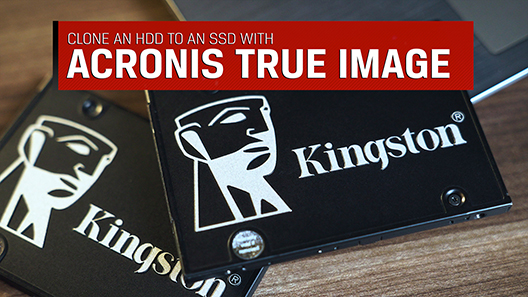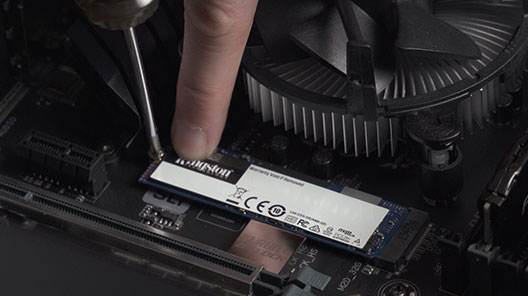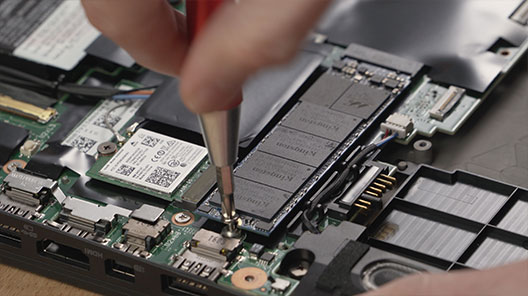
KC3000 PCIe 4.0 NVMe M.2 SSD - Assistance technique
Ressources
Vidéos
Questions fréquentes
1. Téléchargez Kingston SSD Manager sur https://www.kingston.com/support/technical/ssdmanager pour vérifier si une mise à jour du firmware est disponible pour votre SSD et, le cas échéant, appliquez la mise à jour (si elle est recommandée).
2. Consultez la page de support du fabricant de votre système pour vérifier si une mise à jour du BIOS est disponible pour votre système.
3. Assurez-vous d’utiliser la dernière version de votre système d’exploitation et qu’aucune mise à jour n’est en attente.
4. Assurez-vous d’utiliser les derniers pilotes pour votre système. Vous pouvez le faire en visitant la page d’aide du fabricant de votre système et en recherchant les dernières mises à jour des pilotes.
Si vous rencontrez toujours des problèmes avec votre système après avoir suivi ces étapes, contactez le Support technique de Kingston.
FAQ: KSD-012010-001-21
Cela a-t-il été utile ?
Ce phénomène est courant pour le stockage Flash, qu’il s’agisse d’un SSD interne ou d’un stockage USB externe, et s'explique en partie par une différence dans la manière dont les fabricants de disques durs à mémoire flash ou à plateau tournant calculent le mégaoctet. Les fabricants de disques durs calculent un mégaoctet (ou 1 000 x 1 000 octets) comme étant 1 000 Ko, alors que le calcul binaire pour le stockage Flash est de 1 024 Ko.
Example : Pour un appareil de stockage à mémoire Flash de 1 To, Windows calculera qu’il a une capacité de 931,32 Go. (1 000 000 000 000÷1 024÷1 024÷1 024=931,32 Go).
En outre, Kingston réserve une partie de la capacité indiquée pour le formatage et d’autres fonctions telles que le firmware et/ou les informations spécifiques au contrôleur, ce qui fait qu’une partie de la capacité indiquée n’est pas disponible pour le stockage de données.
FAQ: KDT-010611-GEN-06
Cela a-t-il été utile ?
FAQ: KSD-001525-001-00
Cela a-t-il été utile ?
FAQ: KSD-012010-001-00
Cela a-t-il été utile ?
FAQ: KSD-012010-001-01
Cela a-t-il été utile ?
Si ce n’est pas possible, ou si vous avez précédemment cloné vos anciennes données sur votre nouveau SSD, assurez-vous que le nouveau SSD apparaît en tant que disque de démarrage dans le BIOS du système, puis sélectionnez-le pour le démarrage.
FAQ: KSD-012010-001-03
Cela a-t-il été utile ?
-Assurez-vous que le BIOS du système reconnaît votre nouveau SSD. Si ce n’est pas le cas, visitez le site web du fabricant de la carte mère/du système pour voir si un nouveau BIOS est disponible.
-Vérifiez que les paramètres de votre BIOS sont configurés pour accepter un nouveau SSD NVMe.
-Assurez-vous que votre système d’exploitation cible prend en charge les SSD NVMe (Ex : Windows 8 ou ultérieur)
Remarque : Les SSD Kingston ne nécessitent pas de pilotes supplémentaires pour fonctionner.
FAQ: KSD-012010-001-05
Cela a-t-il été utile ?
https://support.microsoft.com/en-us/topic/update-to-add-native-driver-support-in-nvm-express-in-windows-7-and-windows-server-2008-r2-03cd423b-d42e-66c2-722b-019d16455a6b
FAQ: KSD-012010-001-06
Cela a-t-il été utile ?
FAQ: KSD-012010-001-07
Cela a-t-il été utile ?
Si le SSD est présent dans le BIOS, vous devrez peut-être initialiser le disque dans le système d’exploitation.
Pour Windows:
Étape 1 : Assurez-vous que le SSD est correctement branché et mettez le système sous tension, puis démarrez le système d’exploitation Windows.
Étape 2 : Appuyez sur les touches Windows + X et choisissez Gestion des disques.
Étape 3 : Si le SSD est neuf et n’a pas été initialisé, une fenêtre contextuelle s’affiche et indique « Initialiser le disque ».
Étape 4 : Choisissez entre :
MBR (Master Boot Record) : Convient aux disques de moins de 2 To et aux systèmes plus anciens.
GPT (GUID Partition Table) : Recommandé pour les systèmes modernes et les disques de plus de 2 To.
Étape 5 : Cliquez sur OK pour initialiser le SSD.
Étape 6 : Une fois initialisé, vous verrez le SSD comme « Non alloué ». Cliquez dessus avec le bouton droit de la souris et sélectionnez Nouveau volume simple.
Étape 7 : Suivez les instructions à l’écran pour formater le SSD et lui attribuer une lettre.
Pour Mac:
Étape 1 : Assurez-vous que le SSD est correctement branché et mettez le système sous tension, puis démarrez le système d’exploitation Mac.
Étape 2 : Ouvrez l’Utilitaire de disque (vous pouvez le trouver en utilisant Spotlight avec Cmd + Espace et en tapant « Utilitaire de disque »).
Étape 3 : Dans le volet de gauche, sélectionnez votre SSD.
Étape 4 : Cliquez sur Effacer.
Étape 5 : Donnez un nom au SSD et, sous Format, choisissez :
APFS pour les Mac les plus récents et les SSD.
Mac OS Extended (Journaled) pour les systèmes plus anciens ou les disques durs.
Étape 6 : Cliquez sur Effacer. Une fois le processus terminé, le SSD sera prêt à être utilisé.
Pour Linux:
Étape 1 : Assurez-vous que le SSD est correctement branché et mettez le système sous tension, puis démarrez le système d’exploitation Linux.
Étape 2 : Ouvrez un terminal.
Étape 3 : Saisissez sudo fdisk -l pour répertorier tous les disques connectés. Identifiez votre SSD par sa taille et notez le nom de l’appareil, par exemple, /dev/sdb.
Étape 4 : Initialisez le SSD à l’aide de fdisk ou de parted. Voici un guide de base sur l’utilisation de fdisk :
Saisissez sudo fdisk /dev/sdb (remplacez /dev/sdb par le nom de votre SSD).
Appuyez sur g pour créer une nouvelle table de partition GPT.
Appuyez sur n pour créer une nouvelle partition. Suivez les invites pour spécifier la taille et le type.
Appuyez sur w pour enregistrer les modifications.
Étape 5 : Formatez la nouvelle partition sur le SSD (par exemple, /dev/sdb1). Vous pouvez la formater avec le système de fichiers de votre choix :
Pour ext4 : sudo mkfs.ext4 /dev/sdb1
Pour ext3 : sudo mkfs.ext3 /dev/sdb1
Pour FAT32 : sudo mkfs.vfat /dev/sdb1
Étape 6 : Montez le SSD :
Créez un point de montage : sudo mkdir /mnt/myssd
Montez le SSD : sudo mount /dev/sdb1 /mnt/myssd
N’oubliez pas de remplacer /dev/sdb1 par le nom de la partition de votre SSD.
FAQ: KSD-012010-001-15
Cela a-t-il été utile ?
FAQ: KSD-012010-001-18
Cela a-t-il été utile ?
https://www.kingston.com/blog/pc-performance/two-types-m2-vs-ssd
FAQ: KSD-012010-001-16
Cela a-t-il été utile ?
Si votre SSD nécessite un nouveau firmware, vous recevrez une notification lors de l’exécution du logiciel SSD Manager de Kingston, situé ici : www.kingston.com/ssdmanager
FAQ: KSD-012010-001-11
Cela a-t-il été utile ?
M.2 est le facteur de forme physique. SATA et PCIe désignent l'interface de stockage. La différence principale réside dans la performance et le protocole (langage) du SSD M.2.
Les spécifications du M.2 sont conçues pour assurer sa compatibilité avec les interfaces SATA et PCIe des SSD. Les SSD M.2 SATA utilisent le même contrôleur actuellement utilisé sur les SSD SATA 2,5 pouces. Les SSD M.2 PCIe utilisent un contrôleur spécifiquement conçu pour le protocole PCIe. Un SSD M.2 peut supporter un seul protocole, mais sur certains systèmes des emplacements M.2 acceptent soit l'interface SATA ou PCIe.
FAQ: KSD-004005-001-00
Cela a-t-il été utile ?
https://www.kingston.com/blog/pc-performance/nvme-vs-sata
FAQ: KSD-012010-001-19
Cela a-t-il été utile ?
FAQ: KSD-012010-001-04
Cela a-t-il été utile ?
Si votre SSD nécessite un nouveau firmware, vous recevrez une notification lors de l’exécution du logiciel SSD Manager de Kingston, situé ici : www.kingston.com/ssdmanager
FAQ: KSD-012010-001-11
Cela a-t-il été utile ?
FAQ: KSD-012010-001-12
Cela a-t-il été utile ?
FAQ: KSD-012010-001-13
Cela a-t-il été utile ?
FAQ: KSD-012010-001-14
Cela a-t-il été utile ?
FAQ: KSD-012010-001-04
Cela a-t-il été utile ?
-Assurez-vous que le BIOS du système reconnaît votre nouveau SSD. Si ce n’est pas le cas, visitez le site web du fabricant de la carte mère/du système pour voir si un nouveau BIOS est disponible.
-Vérifiez que les paramètres de votre BIOS sont configurés pour accepter un nouveau SSD NVMe.
-Assurez-vous que votre système d’exploitation cible prend en charge les SSD NVMe (Ex : Windows 8 ou ultérieur)
Remarque : Les SSD Kingston ne nécessitent pas de pilotes supplémentaires pour fonctionner.
FAQ: KSD-012010-001-05
Cela a-t-il été utile ?
Si le SSD est présent dans le BIOS, vous devrez peut-être initialiser le disque dans le système d’exploitation.
Pour Windows:
Étape 1 : Assurez-vous que le SSD est correctement branché et mettez le système sous tension, puis démarrez le système d’exploitation Windows.
Étape 2 : Appuyez sur les touches Windows + X et choisissez Gestion des disques.
Étape 3 : Si le SSD est neuf et n’a pas été initialisé, une fenêtre contextuelle s’affiche et indique « Initialiser le disque ».
Étape 4 : Choisissez entre :
MBR (Master Boot Record) : Convient aux disques de moins de 2 To et aux systèmes plus anciens.
GPT (GUID Partition Table) : Recommandé pour les systèmes modernes et les disques de plus de 2 To.
Étape 5 : Cliquez sur OK pour initialiser le SSD.
Étape 6 : Une fois initialisé, vous verrez le SSD comme « Non alloué ». Cliquez dessus avec le bouton droit de la souris et sélectionnez Nouveau volume simple.
Étape 7 : Suivez les instructions à l’écran pour formater le SSD et lui attribuer une lettre.
Pour Mac:
Étape 1 : Assurez-vous que le SSD est correctement branché et mettez le système sous tension, puis démarrez le système d’exploitation Mac.
Étape 2 : Ouvrez l’Utilitaire de disque (vous pouvez le trouver en utilisant Spotlight avec Cmd + Espace et en tapant « Utilitaire de disque »).
Étape 3 : Dans le volet de gauche, sélectionnez votre SSD.
Étape 4 : Cliquez sur Effacer.
Étape 5 : Donnez un nom au SSD et, sous Format, choisissez :
APFS pour les Mac les plus récents et les SSD.
Mac OS Extended (Journaled) pour les systèmes plus anciens ou les disques durs.
Étape 6 : Cliquez sur Effacer. Une fois le processus terminé, le SSD sera prêt à être utilisé.
Pour Linux:
Étape 1 : Assurez-vous que le SSD est correctement branché et mettez le système sous tension, puis démarrez le système d’exploitation Linux.
Étape 2 : Ouvrez un terminal.
Étape 3 : Saisissez sudo fdisk -l pour répertorier tous les disques connectés. Identifiez votre SSD par sa taille et notez le nom de l’appareil, par exemple, /dev/sdb.
Étape 4 : Initialisez le SSD à l’aide de fdisk ou de parted. Voici un guide de base sur l’utilisation de fdisk :
Saisissez sudo fdisk /dev/sdb (remplacez /dev/sdb par le nom de votre SSD).
Appuyez sur g pour créer une nouvelle table de partition GPT.
Appuyez sur n pour créer une nouvelle partition. Suivez les invites pour spécifier la taille et le type.
Appuyez sur w pour enregistrer les modifications.
Étape 5 : Formatez la nouvelle partition sur le SSD (par exemple, /dev/sdb1). Vous pouvez la formater avec le système de fichiers de votre choix :
Pour ext4 : sudo mkfs.ext4 /dev/sdb1
Pour ext3 : sudo mkfs.ext3 /dev/sdb1
Pour FAT32 : sudo mkfs.vfat /dev/sdb1
Étape 6 : Montez le SSD :
Créez un point de montage : sudo mkdir /mnt/myssd
Montez le SSD : sudo mount /dev/sdb1 /mnt/myssd
N’oubliez pas de remplacer /dev/sdb1 par le nom de la partition de votre SSD.
FAQ: KSD-012010-001-15
Cela a-t-il été utile ?
FAQ: KSD-012010-001-18
Cela a-t-il été utile ?
https://www.kingston.com/blog/pc-performance/two-types-m2-vs-ssd
FAQ: KSD-012010-001-16
Cela a-t-il été utile ?
FAQ: KSD-012010-001-04
Cela a-t-il été utile ?
FAQ: KSD-012010-001-00
Cela a-t-il été utile ?
FAQ: KSD-012010-001-01
Cela a-t-il été utile ?
Si ce n’est pas possible, ou si vous avez précédemment cloné vos anciennes données sur votre nouveau SSD, assurez-vous que le nouveau SSD apparaît en tant que disque de démarrage dans le BIOS du système, puis sélectionnez-le pour le démarrage.
FAQ: KSD-012010-001-03
Cela a-t-il été utile ?
-Assurez-vous que le BIOS du système reconnaît votre nouveau SSD. Si ce n’est pas le cas, visitez le site web du fabricant de la carte mère/du système pour voir si un nouveau BIOS est disponible.
-Vérifiez que les paramètres de votre BIOS sont configurés pour accepter un nouveau SSD NVMe.
-Assurez-vous que votre système d’exploitation cible prend en charge les SSD NVMe (Ex : Windows 8 ou ultérieur)
Remarque : Les SSD Kingston ne nécessitent pas de pilotes supplémentaires pour fonctionner.
FAQ: KSD-012010-001-05
Cela a-t-il été utile ?
https://support.microsoft.com/en-us/topic/update-to-add-native-driver-support-in-nvm-express-in-windows-7-and-windows-server-2008-r2-03cd423b-d42e-66c2-722b-019d16455a6b
FAQ: KSD-012010-001-06
Cela a-t-il été utile ?
FAQ: KSD-012010-001-18
Cela a-t-il été utile ?
Si le SSD est présent dans le BIOS, vous devrez peut-être initialiser le disque dans le système d’exploitation.
Pour Windows:
Étape 1 : Assurez-vous que le SSD est correctement branché et mettez le système sous tension, puis démarrez le système d’exploitation Windows.
Étape 2 : Appuyez sur les touches Windows + X et choisissez Gestion des disques.
Étape 3 : Si le SSD est neuf et n’a pas été initialisé, une fenêtre contextuelle s’affiche et indique « Initialiser le disque ».
Étape 4 : Choisissez entre :
MBR (Master Boot Record) : Convient aux disques de moins de 2 To et aux systèmes plus anciens.
GPT (GUID Partition Table) : Recommandé pour les systèmes modernes et les disques de plus de 2 To.
Étape 5 : Cliquez sur OK pour initialiser le SSD.
Étape 6 : Une fois initialisé, vous verrez le SSD comme « Non alloué ». Cliquez dessus avec le bouton droit de la souris et sélectionnez Nouveau volume simple.
Étape 7 : Suivez les instructions à l’écran pour formater le SSD et lui attribuer une lettre.
Pour Mac:
Étape 1 : Assurez-vous que le SSD est correctement branché et mettez le système sous tension, puis démarrez le système d’exploitation Mac.
Étape 2 : Ouvrez l’Utilitaire de disque (vous pouvez le trouver en utilisant Spotlight avec Cmd + Espace et en tapant « Utilitaire de disque »).
Étape 3 : Dans le volet de gauche, sélectionnez votre SSD.
Étape 4 : Cliquez sur Effacer.
Étape 5 : Donnez un nom au SSD et, sous Format, choisissez :
APFS pour les Mac les plus récents et les SSD.
Mac OS Extended (Journaled) pour les systèmes plus anciens ou les disques durs.
Étape 6 : Cliquez sur Effacer. Une fois le processus terminé, le SSD sera prêt à être utilisé.
Pour Linux:
Étape 1 : Assurez-vous que le SSD est correctement branché et mettez le système sous tension, puis démarrez le système d’exploitation Linux.
Étape 2 : Ouvrez un terminal.
Étape 3 : Saisissez sudo fdisk -l pour répertorier tous les disques connectés. Identifiez votre SSD par sa taille et notez le nom de l’appareil, par exemple, /dev/sdb.
Étape 4 : Initialisez le SSD à l’aide de fdisk ou de parted. Voici un guide de base sur l’utilisation de fdisk :
Saisissez sudo fdisk /dev/sdb (remplacez /dev/sdb par le nom de votre SSD).
Appuyez sur g pour créer une nouvelle table de partition GPT.
Appuyez sur n pour créer une nouvelle partition. Suivez les invites pour spécifier la taille et le type.
Appuyez sur w pour enregistrer les modifications.
Étape 5 : Formatez la nouvelle partition sur le SSD (par exemple, /dev/sdb1). Vous pouvez la formater avec le système de fichiers de votre choix :
Pour ext4 : sudo mkfs.ext4 /dev/sdb1
Pour ext3 : sudo mkfs.ext3 /dev/sdb1
Pour FAT32 : sudo mkfs.vfat /dev/sdb1
Étape 6 : Montez le SSD :
Créez un point de montage : sudo mkdir /mnt/myssd
Montez le SSD : sudo mount /dev/sdb1 /mnt/myssd
N’oubliez pas de remplacer /dev/sdb1 par le nom de la partition de votre SSD.
FAQ: KSD-012010-001-15
Cela a-t-il été utile ?
FAQ: KSD-012010-001-14
Cela a-t-il été utile ?
FAQ: KSD-012010-001-13
Cela a-t-il été utile ?
FAQ: KSD-012010-001-12
Cela a-t-il été utile ?
Si votre SSD nécessite un nouveau firmware, vous recevrez une notification lors de l’exécution du logiciel SSD Manager de Kingston, situé ici : www.kingston.com/ssdmanager
FAQ: KSD-012010-001-11
Cela a-t-il été utile ?
FAQ: KSD-012010-001-07
Cela a-t-il été utile ?
https://www.kingston.com/blog/pc-performance/two-types-m2-vs-ssd
FAQ: KSD-012010-001-16
Cela a-t-il été utile ?


